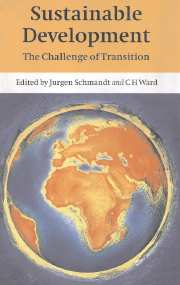Book contents
- Frontmatter
- Contents
- List of contributors
- Foreword
- Preface
- 1 Challenge and response
- 2 National self-interest in the pursuit of sustainable development
- 3 Uneconomic growth: Empty-world versus full-world economics
- 4 Population and consumption: From more to enough
- 5 Spirituality and sustainability
- 6 Leadership skills for sustainable development
- 7 The role of science: Guidance and service
- 8 Economic tools, international trade, and the role of business
- 9 Stakeholders and sustainable development
- 10 From idea to action: The role of policy
- Index
1 - Challenge and response
Published online by Cambridge University Press: 17 August 2009
- Frontmatter
- Contents
- List of contributors
- Foreword
- Preface
- 1 Challenge and response
- 2 National self-interest in the pursuit of sustainable development
- 3 Uneconomic growth: Empty-world versus full-world economics
- 4 Population and consumption: From more to enough
- 5 Spirituality and sustainability
- 6 Leadership skills for sustainable development
- 7 The role of science: Guidance and service
- 8 Economic tools, international trade, and the role of business
- 9 Stakeholders and sustainable development
- 10 From idea to action: The role of policy
- Index
Summary
Albert Toynbee, in his monumental study of world history, used the concepts of “Challenge and Response” to explain how civilizations rise and fall. He felt that traditional explanations – environment, race, leadership, possession of land, access to natural resources – were wrong or too narrow. Instead, he looked for the underlying cause that explained societal success or failure. By “challenge” Toynbee meant some unpredictable factor or event that posed a threat to the ways in which a group of people had made their livelihood in the past. But “challenge” was not all negative. It carried in it the germ of opportunity. “Response” was the action taken by the same group of people to cope with the new situation. A challenge would arise as the result of many things – population growth, exhaustion of a vital resource, climate change. It was something that nobody had knowingly created. Response required vision, leadership, and action to overcome the threat and create a basis for survival and, hopefully, prosperity.
Because he analyzed large civilizations, Toynbee reserved the terms “challenge and response” for major threats and actions that impacted the well-being of the entire population. “Challenge” threatened the very survival of the existing system. “Response” would range from inaction to major change in the living conditions of individuals as well as the group. It could embody new technology, social organization, and economic activities, or a combination of various factors. “Response” was never predictable, and its outcome would only be known over time. This was the risk humans took – resulting in success or failure.
Information
- Type
- Chapter
- Information
- Sustainable DevelopmentThe Challenge of Transition, pp. 1 - 10Publisher: Cambridge University PressPrint publication year: 2000
Accessibility standard: Unknown
Why this information is here
This section outlines the accessibility features of this content - including support for screen readers, full keyboard navigation and high-contrast display options. This may not be relevant for you.Accessibility Information
- 5
- Cited by
